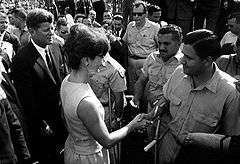Golden exile
The emigration of Cubans, from the 1959 Cuban Revolution to October of 1962, has been dubbed the Golden exile and the first emigration wave in the greater Cuban exile. The exodus was referred to as the "Golden exile" because of the mainly upper and middle class character of the emigrants. After the success of the revolution various Cubans who had allied themselves or worked with the overthrown Batista regime fled the country. Later as the Fidel Castro government began nationalizing industries many Cuban professionals would flee the island.[1] This period of the Cuban exile is also referred to as the Historical exile, mainly by those who emigrated during this period.[2]
| Part of the Cuban exile | |
 Cuban exiles in Brigade 2506 meeting President Kennedy | |
| Date | 1959 – 1962 |
|---|---|
| Location | |
| Also known as | Historical exile |
| Cause |
|
| Outcome |
|
History
1959 - 1960
The first to emigrate after the revolution were those who were associated or worked for the old Batista regime. The U.S. embassy in Havana and consulate in Santiago would regularly grant visas to Cubans wishing to leave.[2]
By the middle of 1959 various new policies had affected Cuban life such as the redistribution of property, nationalization of religious and private schools, and the banning of racially exclusive social clubs. Those that began to leave the island were driven by them being negatively affected by new economic policies, their distaste with new national public schools, or anxiety over government supported racial integration. The government would quickly label exiles who left as "racists", discouraging Afro-Cubans to also emigrate. These conditions caused the majority of those who emigrated to be either upper or middle class, white, and catholic.[3] Many middle class emigrants were often professionals that were tied to American companies that were nationalized.[4]
Many of the emigrants that would leave believed they would be returning soon to Cuba,[1] believing the U.S. would soon intervene and overthrow the Fidel Castro government.[5] Some of those exiled in the United States would organize a militant resistance to the Fidel Castro government.[4]
1961
On January 3, 1961 the United States broke off diplomatic relations with Cuba and afterwards emigrants gained visas for humanitarian reasons, and after arriving in the United States they could apply for parole and gain refugee status.[2]
In April of 1961 the Bay of Pigs Invasion consisting of many militant and anti-fidelista Cuban exiles would fail to take over Cuba.[4] Afterwards those who would choose to emigrate would view their decision as a permanent one.[5] Fidel Castro would then term those leaving "gusanos" (worms).[5]
Growing controversy in Cuba with the nationalization of Catholic schools spurred the development of Operation Peter Pan to relocate children to the United States.[4]
1962
During the Cuban Missile Crisis of October 1962, travel between the United States and Cuba became restricted. Afterwards Cuban emigration would occur using makeshift vessels illegally leaving Cuba. From 1959 to the end of open travel in 1962 around 250,000 Cubans left the island.[1] The
Golden exiles
Demographics
Researcher Jorge Duany claims the majority of exiles were urban, middle-aged, well-educated, light-skinned, and white-collar workers, who emigrated primarily did so for religious, or political reasons. He also claims that while the first emigrants left because they were old Bastianos, those after left because of disillusionment with the new government and because economic reforms and nationalizations of American companies had harmed their professions.[1] Researchers Irving Louis Horowitz and Jaime Suchlick have claimed about half of those who emigrated were blue collar workers and many of those were agricultural workers and fishermen. They also proposed many left because of Cuba's new rationing system and mandatory military service.[4]
Horowitz and Suchlick claim that while most emigrants were not involved in militant movements a majority did financial support them until later becoming disillusioned after the failures of such movements.[4]
"Golden exile" identity
The identity of "golden exile" has been used in Cuban-American circles as an identity to distinguish Cuban Americans who are seen as racially white and exuding conservative values as compared to Cuban Americans who came later in the Cuban exile who may have darker skin.[6] The term "golden exile" has also been used in discussions involving immigration as a term to glorify Cuban immigrants as anti-communist political refugees and productive members of the middle class. This term has spurred controversy due to statistics countering this image.[7]
See Also
References
- "Cuban communities in the United States: migration waves, settlement patterns and socioeconomic diversity". journals.openedition.org. Retrieved 2019-12-06.
- "Cuban Migration: A Postrevolution Exodus Ebbs and Flows". migrationpolicy.org. Retrieved 2019-12-06.
- "Not Blacks, But Citizens! Racial Politics in Revolutionary Cuba, 1959-1961" (PDF). www.semanticscholar.org. University of North Carolina at Chapel Hill. Retrieved 2020-08-15.
- Horowitz, Irving; Suchlicki, Jaime (2001). Cuban Communism. Transaction Publishers. pp. 413–417.
- "Cuba's Revolution and Exodus". The Journal of the International Institute. Retrieved 2019-12-06.
- Helmick, Gregory (2016). Archival Dissonance in the U.S. Cuban Post-Exile Novel. Cambridge Scholars Publishing. pp. 43–44.
- Perez-Lopez, Jorge (1993). Cuban Studies 23. University of Pittsburgh Press. p. 168.